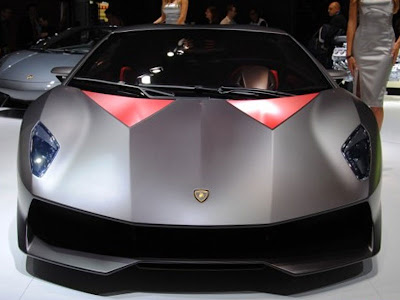The name comes from the animal world, as Pandion Haliaetus is the scientific name for an Osprey: a sea hawk that nests and lives in coastal areas. The designers, led by Mike Robinson, have drawn inspiration from the wings of this predator to invent the spectacular door opening mechanisms, and from the hawks' facial markings to project the traditional Alfa family feeling into the next era of design.
Bertone Pandion Concept 2010 Alfa Romeo Sports Cars Concept
Bertone returns to the Geneva Motor Show 2010, after a two year absence from the international scene, unveiling a concept car that makes its world premiere here: the Pandion, an aggressive yet beautiful coupé designed as a tribute to Alfa Romeos’ one hundred year anniversary. The Alfa Romeo Pandion Concept: an extreme and controversial sports car in typical Bertone fashion. The size of the concept car (4620 mm in length, 1971 mm wide, 1230 mm high, 2850 mm wheelbase) offers a compact sports car external dimensions with a large sports car interior feeling. Bertone Pandion Design Sketchoffers a compact sports car external dimensions with a large sports car interior feeling, all powered by a 4.7 litre, 450 CV 8-cylinder Alfa Romeo engine.

The designers, led by Mike Robinson, have drawn inspiration from the wings of this predator to invent the spectacular door opening mechanisms, and from the hawks’ facial markings to project the traditional Alfa family feeling into the next era of design. In almost a century of Bertone tradition, it is not the first time that natural wonders have inspired the names of concept cars. Just think of the Corvair Testudo (1963) and, by no coincidence, the Alfa Romeo Canguro (1964), Carabo (1968) and Delfino (1983).
Bertone Pandion Concept 2010 Alfa Romeo Sports Cars Concept
The Pandion’s taut and muscular body is the result of an original interpretation of the Alfa Romeo badge, where the man-eating snake depicted there represents the attraction of elegance (what we call the ‘Skin’), and the aristocratic cross symbolises the rigour of rational thought, the technological aspect (what we call the ‘Frame’).
According to this interpretation, the Pandion’s design is, like every Alfa Romeo, a perfect synthesis between ‘Skin and Frame’, an ideal balance resulting from a tension between opposites: technology and sensuality, rationality and instinct, architecture and sculpture, structuralism and organicism, industrial excellence and excellent craftsmanship.

The design of the Pandion is based on a concept Robinson calls: "Skin & Frame” - a new interpretation of the inherent duality in the 100 year old Alfa Romeo logo. “Skin” refers to the snake in the logo, representing the world renowned Italian excellence in beautiful, seductive forms; and “Frame” refers to the cross in the logo, representing the mechanical excellence in high performance Italian race cars. The combination of the two has now become a dynamic dial searching for an ideal balance resulting from the tension between opposites: technology and sensuality, rational and emotional, architectural layout and sculptural form, structural and organic, industrial excellence and artisan excellence.
Bertone Pandion Concept 2010 Alfa Romeo Sports Cars Concept
According to this interpretation, the vibrant energy in every Alfa Romeo is represented by Pandions’ spinal structure (or ‘Frame’), which crosses the length of the car from the V-shaped grille in the nose of the car to the V-shaped bumper in the tail of the car, crossing the interior as a visually aesthetic structural element which supports the surrounding shell (or ‘Skin’).
The Alfa Romeo Pandion Concept has the profile of a true sports car, with no room for compromise. The architectural layout is 'cab rearward', meaning the passenger compartment is positioned towards the rear of the car and the long bonnet pushes the car's visual centre rearward. The body side visually connects the sensuous front end with the razor-edged rear by means of an extremely long flowing side window which stretches from front wheel arch to rear, enhancing the excellent accessibility of this low-bodied sports coupé.
Bertone Pandion Concept 2010 Alfa Romeo Sports Cars Concept
Since sports cars are traditionally difficult to get in and out of, this important ergonomic activity has been facilitated with an extra wide door opening to make up for the low roofline. This new graphic formula not only adds a striking new visual division between the upper and lower parts of the body, but it also offers an incredible panorama window for passengers inside. The strong diagonal dark-light division in the rear of the side view accentuates the powerful rear wheel drive layout and draws special attention to the hidden door opening mechanism.
 The Lamborghini Sesto Elemento Concept has been presented live at the 2010 Paris Motor Show. Sesto Elemento is Italian for sixth element, which is where carbon sits on the periodic table. And while the design of the carbon fibre constructed show car will certainly influence the Murciélago and Gallardo replacements, it’s also a blueprint for the firm’s expanding expertise in the use of this strong, lightweight material.
The Lamborghini Sesto Elemento Concept has been presented live at the 2010 Paris Motor Show. Sesto Elemento is Italian for sixth element, which is where carbon sits on the periodic table. And while the design of the carbon fibre constructed show car will certainly influence the Murciélago and Gallardo replacements, it’s also a blueprint for the firm’s expanding expertise in the use of this strong, lightweight material.






















































